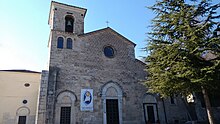Venafro Cathedral

Venafro Cathedral (
History
The cathedral is not only the biggest church in the city but is also one of the largest in the region. It stands at the foot of the Parco Oraziano, a park leading up into the surrounding mountains. At the end of the fifth century, the first Christian church on the site was constructed by Bishop Constantine over a pagan temple, reusing building materials from older buildings both

It was rebuilt in the second half of the 11th century by Bishop Pietro of Ravenna, commemorated by a
The cathedral's present aspect is due to restoration works carried out in the 1960s and 1970s which removed the Baroque additions, returning it to a Gothic medieval appearance.
Interior

The interior has three aisles decorated by pictorial work from the 14th century. The church has five portals: the one to the right of the main portal is a holy door (porta sancta) of 1508. Four side-chapels open off the southern aisle, while off the northern aisle is the very large chapel known as the "Cappellone", built in the late 17th century and remodelled in the 19th, for the administration and reservation of the sacrament.
The chapel of the Crucifix (Crucefisso) was completed in the 16th century. The altarpiece is attributed to the school of Domenico Antonio Vaccaro. The marble bust (1795) of the cleric, (Primicerio) Antonio Rosario De bellis, was completed by Michele Coppa.[1]
External links
- Diocesan website :Venafro Cathedral (in Italian)
41°29′02″N 14°02′18″E / 41.4838°N 14.0382°E
